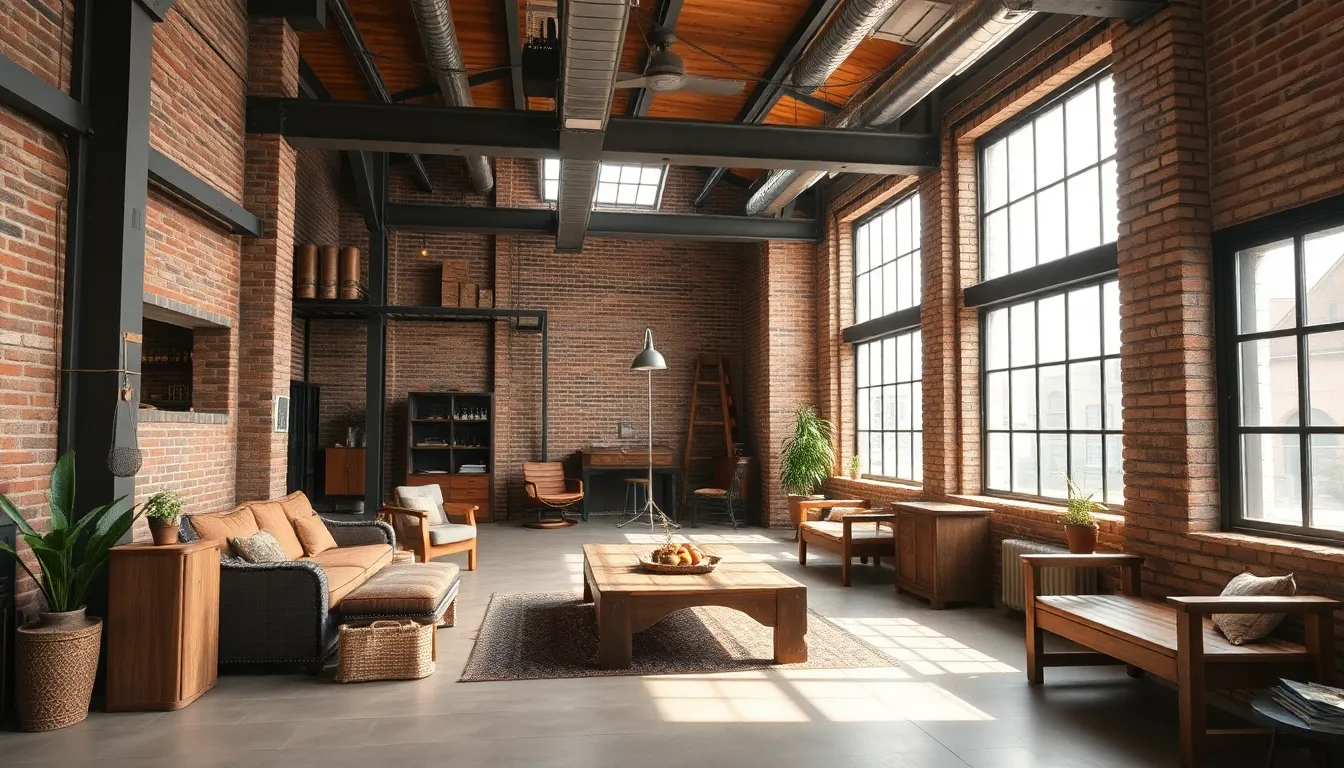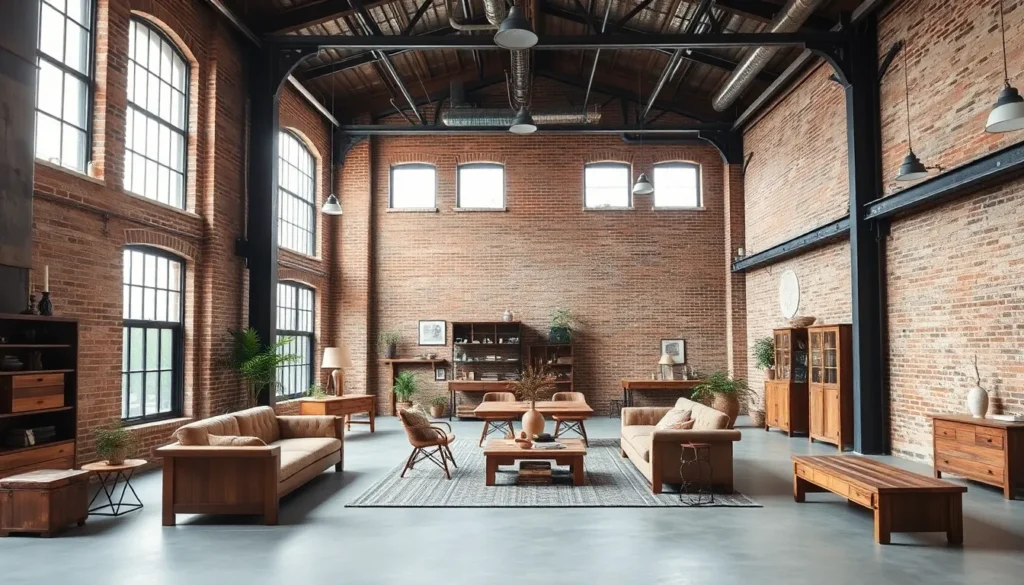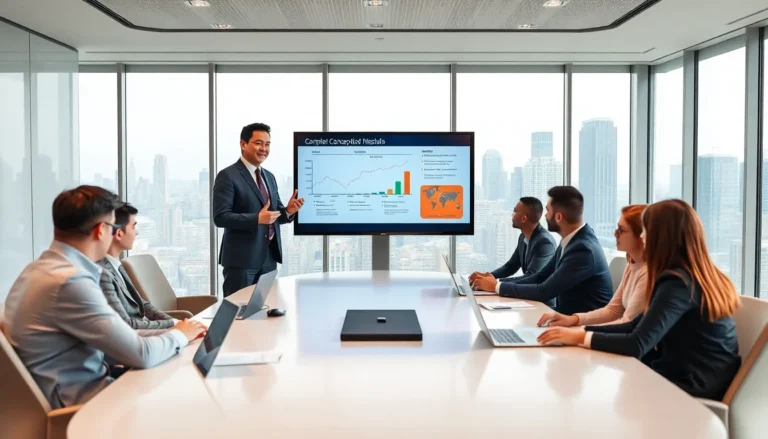Table of Contents
TogglePicture this: exposed brick walls, steel beams, and a vibe that screams “I mean business.” Industrial interiors have taken the design world by storm, transforming dull spaces into trendy havens. It’s not just about aesthetics; it’s about creating an atmosphere that blends functionality with a touch of rugged charm.
Overview of Industrial Interiors
Industrial interiors gained traction for their unique blend of raw aesthetics and practical functionality. This design style prominently features elements such as exposed brick walls, steel beams, and wooden accents. Elements from warehouses and factories bring a distinct character to modern spaces.
Textures play a crucial role in industrial design. Rough finishes, reclaimed materials, and vintage furnishings contribute to an authentic atmosphere. Open floor plans often characterize these spaces, encouraging creativity and collaboration. High ceilings and large windows allow natural light to enhance the overall experience.
Color palettes tend to lean toward neutral tones, with gray, brown, and black being popular choices. These colors serve to highlight the raw materials and create a cohesive environment. Fixtures are commonly metallic or distressed, adding to the rugged charm synonymous with industrial styles.
Furniture options in industrial interiors frequently include minimalist designs. Pieces made from metal or reclaimed wood promote durability while maintaining visual appeal. Artwork and decorative items often feature a vintage or mechanical theme, reinforcing the overall concept.
Functionality remains a fundamental aspect of industrial interiors. Spaces are designed to be practical, emphasizing efficiency without sacrificing aesthetic value. Multi-purpose areas often emerge, allowing for both work and relaxation within the same environment.
This design trend appeals to those seeking a distinctive look that fosters both comfort and innovation. As industrial interiors continue to evolve, their influence on contemporary design remains significant.
Key Elements of Industrial Design

Industrial design showcases a unique blend of aesthetics and functionality, emphasizing raw materials and open spaces.
Materials Used in Industrial Interiors
Brick, concrete, and metal serve as primary materials in industrial design. Exposed brick walls often create a warm yet rugged backdrop. Steel beams add structural integrity while contributing to an industrial aesthetic. Wood, particularly reclaimed options, provides contrast and adds warmth to cold materials. Incorporating glass in partitioning enhances openness without sacrificing light. Surfaces are often left unfinished to showcase their natural beauty, which contrasts with polished elements found in other design styles.
Color Palettes and Textures
Neutral color palettes dominate industrial interiors, with whites, grays, and blacks serving as foundational shades. These choices highlight the raw textures present in materials. Contrast occurs through the introduction of earth tones, creating a balanced environment. Texture plays a pivotal role in adding depth; rough finishes, weathered wood, and patinated metals enhance visual interest. Fixtures are often metallic or distressed, reinforcing the industrial vibe and drawing attention to the unique characteristics of the space.
Popular Trends in Industrial Interiors
Industrial interiors combine functionality with a distinct aesthetic, showcasing unique trends that elevate modern spaces. Notable aspects include open spaces and a focus on vintage decor.
Open Spaces and Layouts
Open floor plans serve as a hallmark of industrial interiors. These layouts encourage creativity and collaboration, fostering an environment that feels spacious. High ceilings draw the eye upward, contributing to an airy feel. Large windows allow natural light to flood in, enhancing the overall ambiance. Such designs accommodate various activities, from work to relaxation, promoting a versatile lifestyle. By eliminating unnecessary walls, the flow of movement improves, offering an uninterrupted experience within the space.
Vintage and Reclaimed Decor
Vintage and reclaimed decor add authenticity to industrial interiors. Items like reclaimed wood furniture offer warmth and character, creating a stunning contrast against raw materials. Antique accessories, such as metal light fixtures or factory-style seating, introduce history into the design. Using reclaimed materials contributes to sustainability while enhancing the rugged charm that defines this trend. Vintage artworks often serve as vibrant focal points, enhancing the overall narrative of the space. This blend of old and new exemplifies a timeless quality, appealing to individuals drawn to a unique and storied aesthetic.
Benefits of Industrial Interiors
Industrial interiors offer numerous advantages for modern spaces. Aesthetic appeal resonates with many, as the style delivers a unique blend of raw materials and rustic charm. Functionality also plays a key role, allowing for efficient designs that cater to various activities.
Open floor plans create an atmosphere conducive to collaboration. High ceilings enhance this effect, making spaces feel bigger and more inviting. Natural light pours in through large windows, improving the overall ambiance and positively impacting mood and productivity.
Durable materials, such as metal, concrete, and reclaimed wood, contribute to longevity. These choices minimize maintenance while providing a rugged, appealing look. Sustainability embodies another major benefit; recycling materials not only reduces waste but also adds character to the design.
Versatile furniture enhances usability, allowing spaces to adapt easily. Minimalist pieces ensure that areas stay uncluttered, maintaining a clean aesthetic. Vintage elements further highlight this charm, bridging the gap between the past and present.
Color palettes typically utilize neutral tones, creating a serene backdrop. Soft whites, grays, and earth tones enhance visual harmony while showcasing the beauty of raw materials. Texture emerges as a crucial factor, adding depth and interest to each element.
Finally, the industrial style invites personalization. Homeowners can integrate their unique tastes into the design while enjoying the inherent ruggedness. This blend of practicality, style, and individuality makes industrial interiors increasingly desirable.
Challenges in Designing Industrial Interiors
Designing industrial interiors presents unique challenges. One major issue involves dealing with space constraints. Many industrial spaces originally served a different purpose, leading to layout difficulties when converting them for modern use. Balancing functionality and aesthetics can prove complex, as designers work to retain the building’s original character while integrating contemporary needs.
Material selection also poses challenges. Choosing the right mix of raw materials is crucial for achieving that authentic industrial look. Designers must consider durability, especially in high-traffic areas, as well as the need to maintain a cohesive visual identity throughout the space. For instance, mixing too many different materials can disrupt the overall aesthetic.
Temperature control remains another crucial factor. High ceilings and vast open spaces often lead to heating and cooling issues. Addressing these may require innovative heating strategies or additional insulation solutions, which can complicate the design process.
Lighting plays a pivotal role in industrial designs. Large windows often provide ample natural light, yet designers should integrate supplemental lighting to ensure functionality, especially in less illuminated areas. Striking the right balance between ambient and task lighting enhances both beauty and practicality.
Finally, incorporating modern technology can clash with the industrial style. Designers face the challenge of blending cutting-edge features without detracting from the rugged elegance. Maintaining the essence of industrial interiors while meeting contemporary technological demands is essential for achieving a well-rounded design.
These challenges emphasize the need for thoughtful planning and creativity in crafting industrial interiors that successfully fuse style, function, and authenticity.
Industrial interiors continue to captivate with their unique blend of rugged charm and practical functionality. This design style not only embraces raw materials but also encourages creativity and collaboration through open spaces. The careful selection of textures and neutral palettes enhances the overall aesthetic while maintaining a sense of warmth and authenticity.
As the trend evolves, challenges like space constraints and temperature control require innovative solutions. However, with thoughtful planning and a focus on sustainability, industrial interiors can provide both style and comfort. This enduring trend remains a popular choice for those looking to create distinctive spaces that reflect their individuality and foster a dynamic atmosphere.




